


Article by Featured Author
Posted July 2016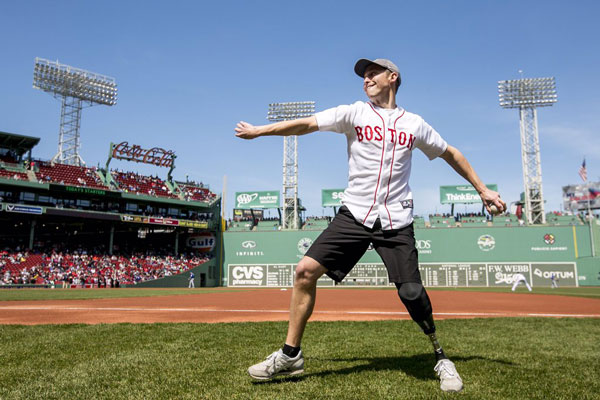
Patrick Downes throws the first pitch out at Fenway Park; from the Boston Red Sox Twitter page.
You may not know the name of 33 year old Adrianne Haslet, but you should. And the same for 32 year old Patrick Downes.
Most have forgotten Jeff Bauman, but few will forget after Jake Gyllenhaal plays Bauman in the big screen movie “Stronger,” being directed by David Gordon Green and to be released in 2017.
Then there was young Martin Richard, who died so unexpectedly when he was only eight years old.
Twenty American veterans of other wars — wounded in Iraq and Afghanistan — were led by double amputee Stefan Leroy of the 82nd Airborne Division that Sunday afternoon into fabled Fenway Park, and the next day from rural Hopkinton, Massachusetts, to Copley Square in downtown Boston, and in the Spring.
The Road Lawyer thought he knew what heroes mean to Boston and its people. TRL got his law degree there. Friends live there. Sons went to school there, and one found a wife at a college not so far west of Greater Boston. Little brother ran The Marathon years ago. Reunions. Business meetings. Visits. “Cheers! Where everybody knows your name.” “Denny Crane of ‘Boston Legal’”.
Did George O’Brien win his election? Did poor Charlie ever get off the “M. T. A.”?!? [For the under 60 set, the references are to a politically oriented ballad by The Kingston Trio; many knew it by heart in the early 1960s.1]
Patriots’ Day weekend 2016 was one chill bumps experience after another, with the fun in abundance found only at ballpark thrown in for good measure.
Schools close all over Massachusetts on the Third Monday of each April. A story is told and retold in the town halls, and via all of the media, one unique within the lore and glory of New England’s Bay State more surely than the story of Plymouth Rock.
There are re-enactments of events in Lexington and Concord back on April 19, 1775. Many still argue the details. Who fired the first shot? On command? By carelessness, nervousness, or from fear? Who was the first to fall?
Ralph Waldo Emerson best taught us none of these questions matter and immortalized the moment with his Concord Hymn (1837)
By the rude bridge that arched the flood,
Their flag to April’s breeze unfurled,
Here once the embattled farmers stood,
And fired the shot heard round the world.
In the 21st century, of course, it has become the last day of another of those the three day holiday weekends so many consider their birthright. It is usually the fourth game of a Red Sox home series played on a green Fenway field, and in the sun, given the time of year. The Canadian-based Toronto Blue Jays were the closest thing to “Red Coats” that could be rounded up for the long weekend skirmish in April of 2016.
Boston has been home to many sports heroes through the years. Heroes called Celtics, Bruins, and, yes, Patriots. And even Red Sox. Only the Giants of San Francisco have also won three World Series in the 21st century.
For 120 years the Greater Boston Area has cheered and honored other heroes on Patriots’ Day. A group that has gradually grown, until now there are thousands of men and women from around the world who come every April to exercise the privilege they have so painfully earned, to run the most storied 26 mile, 385 yard course there is — the Boston Marathon.
The only people who doubt that these men and women are heroes are some of those who have never tried to run a marathon. 27,491 heroes took part in the staggered start of the 120th running of the Boston Marathon.
Sunday afternoon, April 17, 2016, was beautiful in Boston. Temperatures hovered in the upper 60s that afternoon, a dream for those with baseball on their minds. Those set to run the next day were nervous. Marathoners prefer temps about 20 degrees cooler.
Getting to Fenway and to your seat on game day has always been an adventure. Public parking is close to non-existent. Faculty and staff at nearby Boston University have long augmented their salaries not insignificantly by renting their campus parking spaces to Sox fans (or so the saying goes).
Forty-five bucks would get your car parked that Sunday in April 2016, if you got there soon enough — like the night before, as otherwise the traffic was impossible. Wherever you are in the Bay Area, your only practical option is to find your way to the nearest T station (not sure whatever happened to the M. T. A. or poor Charlie2 except that he is memorialized with the cheap, reusable CharlieCard that MBTA proudly promotes), and take the next train to Park Street Station.
There the adventure begins. The old style trolley cars, formally the Green Line, still weave their underground way to and from Park Street. You can’t help wondering whether the trolley system is older (and more quaint!) than Fenway itself, though both have been spruced up a bit since TRL last was here.
One thing hasn’t changed. Securing a few cubical inches of space on the Green Line trolley car on game day is a sardine-like experience. The critical challenge is maintaining a sight line so that you can be sure you are squeezed out of the trolley and on to the platform at Kenmore.
That’s a little trick if you haven’t been to Fenway in a while. Boylston, Arlington and Copley stations are still in place, as they were long before Charlie’s famous and interminable ride. But destination Kenmore a/k/a Kenmore Square is no longer next. Not sure when the Hynes Convention Center stop was inaugurated. Just remember as you are winding your way beneath the streets of Boston, Kenmore is now the fifth stop.3 Of course, you can just go with the flow.
Once you worm your way out of the T car, the anticipation builds. Fans climbing on top of fans, all eagerly ascending the ancient stairways, an inverted funnel to the sunshine. And there it is! You’re still four blocks — and a Mass Pike overpass — away from the rear facade of the Green Monster.
The CITGO sign removes all doubt you exited at the right T stop. As the saying goes, “London has Big Ben, Paris has the Eiffel Tower, and Boston has Fenway Park with the CITGO sign behind it.”
Citgo ran a wonderful full back page ad in the front section of The Boston Glove, Monday, April 18, 2016, with the simple text, “Then at mile 23, I saw the sign. The guy next to me kept encouraging me, and I pushed to the finish.”
When not under oath, TRL has been known to insist that back in the summer of 1989 — his only time at Fenway with a seat behind home plate — he saw a Jim Rice home run go into the tower supporting the CITGO sign, the next-to-last HR the Red Sox Hall of Famer ever hit.
The Cask ‘n Flagon at the corner of Landsdowne and Brookline has also had a face lift but, as usual, it’s packed well over an hour before game time, even on a Sunday afternoon.
Fenway Park opened for business just over a century ago, and in fitting form. The year was 1912. Smokey Joe Wood won 34 games in the era before pitch counts or relief pitchers. Tris Speaker hit .383 and led the Sox to a World Series victory over John McGraw’s New York Giants.
Three years later the Sox had another charmed summer in the Fenway. A big strapping southpaw from Baltimore joined the pitching staff and showed promise with his bat as well. In 1915 the Red Sox bested the Philadelphia Phillies in the World Series. They beat Brooklyn in 1916.
After letting the other Sox team — the one from Chicago — slip ahead in 1917,4 the next year the Babe Ruth-led Boston Red Sox brought Fenway Park its third World Series win in four years. They beat the Chicago Cubs, four games to two.
Everyone in America knows the broad strokes of what happened after that. “Next year” found a new meaning. It’s not just that in 1919, Ruth set a new MLB home run record and was then sold to the despised Yankees. Other top Sox players went south to New York as well.
Red Sox owner Harry Frazee needed far more money for his Broadway musicals than Ruth and his other players could bring, so he mortgaged Fenway Park to the Yankees as collateral security for a $300,000 loan! The Curse of the Bambino was in full force and effect.
The 1918 World Series linked the Sox and the Chicago Cubs5 as the loveable losers in their respective leagues, until the Red Sox’ miracle comeback in 2004.
Understand that The Road Lawyer has had tickets in Fenway’s right field bleachers more than two or three times over the years. There is no way a Sox fan over forty can sit there and not wonder just how many home runs Ted Williams might have hit, if only he had had a short right field porch to shoot at, like the 314 foot one the Yankees built in 1923 for Babe Ruth.
Shortened in 1940 by 23 feet to accommodate the respective bullpens for both team’s relievers, Williams was still looking at a straight-away distance of 380 feet in right field every time he came to the plate in Fenway.
And, of course, if Williams had not lost 4½ years in his baseball prime, serving his country first in World War II and then in Korea? Not only is Ted’s .406 batting average in 1941 likely to make him the last .400 hitter that Major League Baseball will ever see. He is the only player ever to hit a home run in his last time at bat — twice!
John Updike’s paean in the Fall of 19606 made most forget that the Kid hit one out back in May of 1952, just before he left for Korean service flying first wing to John Glenn,7 and at a time when he and most others in baseball assumed his baseball playing days were over.
Of course, you cannot approach those seats in deep right field without straining to see if you can catch a glimpse of the “red seat.” On June 9, 1946, a supposedly still rusty Williams back from WWII hit a pitch so hard and far that it landed on a startled gentleman’s straw hit in the 37th row deep in Fenway’s right field bleachers. That HR has been scientifically measured at 530 feet. The famous seat is painted a bright red.
But back to the future. You hustle across the bridge and on to Yawkey Way. On to Landsdowne, and to Brookline Ave and Van Ness. Over the years more home run balls actually landed on Landsdowne Street than prior to 1957 had hit Flatbush Avenue in Brooklyn.
TRL knew special seating had been added atop the Green Monster but had been curious how such an engineering feat had been accomplished. Then you turn down Landsdowne Street and see the strong green steel supports protruding so sturdily westerly but substantially out from the ballpark proper.
So that’s how they did it! Until suddenly you summon what you can remember of tenth grade geometry to try and figure at what height and distance a baseball would have to be hit so that it could come close to straight down in the end and actually land on Landsdowne Street. It would take a Bucky Dent blooper hit twice as high as the heart-breaking real thing, and even then a helluva wind blowing in from behind “the Monster.” Or has the commentator’s call “over the Green Monster and out on to Lansdowne Street” been reduced to a euphemism?
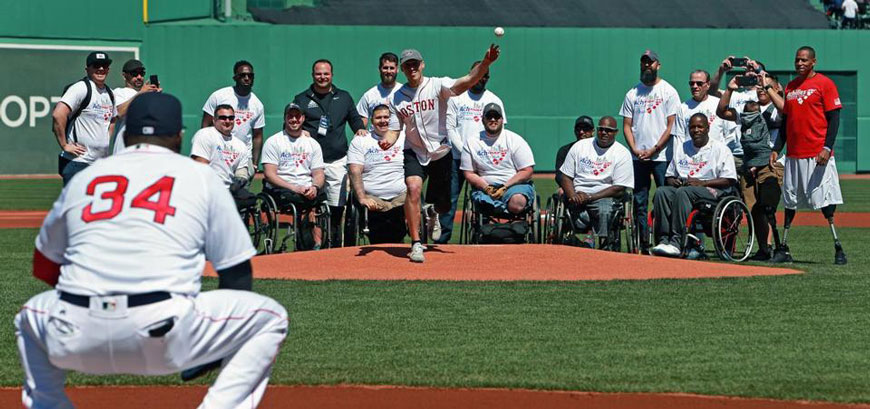
Patrick Downes, backed by members of Achilles Freedom, throws first pitch at Fenway Park; from Boston Globe photo gallery.
TRL and crew, nine in all, were in the right field bleachers that Sunday afternoon. Thanks to the big screen (the one that from those seats largely blocks your view of the CITGO sign), you could see dignitaries assembling around home plate for the ceremonial first pitch. Twenty men, half-a-dozen in wheel chairs, were introduced, members of the Achilles Freedom Team of wounded veterans set to compete in The Marathon the next day.8
Then Patrick Downes stepped forward. He’d lost his left leg below the knee in the 2013 bombing. On that sobering Marathon Monday, there were two young brothers said to have been motivated by jihadist passions about American involvement in Iraq and Afghanistan.
“Sincerely held religious beliefs”9 in their minds’ eye, the brothers exploded two bombs amidst the massive crowd near the marathon finish line. Three people died. Another 264 were wounded.
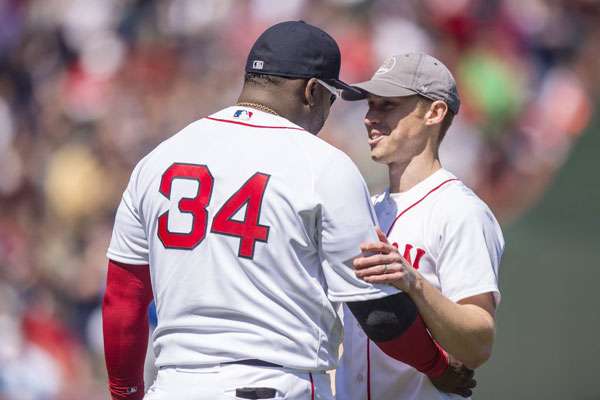
Patrick Downes meets David Ortiz; from the Boston Red Sox Twitter page.
Downes was one of the 264. A southpaw, he would pitch to another kind of Boston hero. Big Papi, as David Ortiz is affectionately known, had announced that he would retire at the end of the 2016 season.10 Downes and his wheelchair mates — vets wounded in Iraq and Afghanistan — were introduced to a thunderous applause. A gigantic American flag covered the Green Monster in left field. Heroes and Country were honored.
Starting pitchers that Sunday afternoon offered a study in contrasts. The Sox sent knuckle baller Steven Wright to the mound. The scoreboard started posting pitch speeds in the mid-70 mph range. The only way you could tell Wright was trying a fast ball was when the pitch gun would hit 83 mph or so. Toronto flame thrower Aaron Sanchez from Barstow, California, regularly registered a 97 or a 98 on the speed gun.
It was no surprise when perennial slugger Jose Bautista of the Dominican Republic smashed a two run home run off of Wright in the top half of the first inning. Hold on to your hats!
But for some reason that was all the damage the Jays could do with Wright. Lots of loud outs. A couple of K’ balls that registered in the 60s on the speed gun, one at a jaw dropping 56 mph! After six innings, the Jays remained stuck on two runs. Globe sports writer Peter Abraham reported the next day that in two starts, 12 and 2/3 innings, Wright had held the hard hitting Blue Jays only three earned runs. He earned himself a spot in the starting rotation.11
At press time, Wright was sporting a 8–5 record, with a 2.18 ERA. Far and away the best among Sox starting pitchers. Compared with big bucks off season acquisition David Price’s 4.68 ERA and veteran Clay Buchholz’ bloated 5.90 ERA, it wasn’t clear who is the more embarrassed, the so called stud starters or Sox player personnel assessors.
Toronto was still ahead 2–0 when the Sox recorded the third out in the top half of the fourth inning. The Fenway public address announcer asked the crowd for quiet for a special introduction.
Mother, father, sister and brother of Martin Richard were presented, honored and loved by the 37,000 plus on hand.12 Young eight year old Martin had been wantonly killed near the Marathon finish line on April 15, 2013.
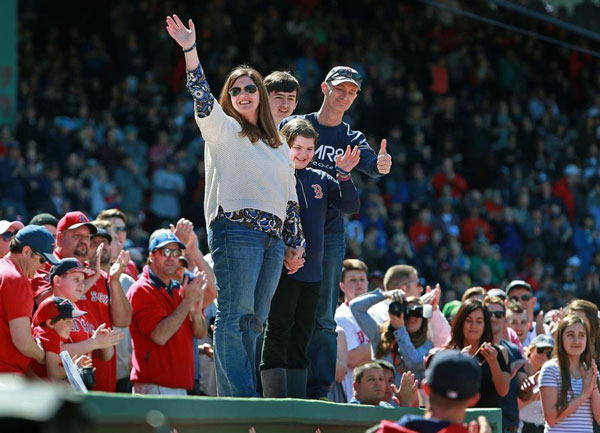
Family of the late Martin Richard atop Boston Red Sox dugout; from Boston Globe photo gallery.
Still beyond belief! A memory painful and vivid, searing the heart of the hometown of long ago Quaker martyrs Marmaduke Stephenson, William Robinson and Mary Dyer, and the more recently of three Kennedy brothers.
Boston’s love affair with David Ortiz began in that magical 2004 playoff run. Papi’s performance against the Yankees, against all odds and spitting in the face of fate and history and a hated curse, filled Beantown fans with an eternal joy no religion can equal.
Fourteen years of memories had the Patriots’ Day weekend Sunday afternoon fans on their feet every time Papi came to the plate. In the bottom of the fourth, he stroked one off of fireballer Sanchez that had that sound, look and feel. Some 37,000 rose as one and with a roar until …, Jays’ outfielder Kevin Pillar reached high and caught the ball, his back against the flag pole in deep left center field.
Sox fans came alive in the bottom of the ninth when Travis Shaw timed a fast ball just right and pulled it into the Sox right field bull pen. Sox were now down only 5–3.
Shaw’s HR landed not too far from where Ted Williams 521st career HR landed in “the Kid’s” last time at bat in on September 28, 1960.
That’s where it ended, two outs later.
The paid attendance at Fenway that Sunday afternoon was 37,497. TRL saw what seemed a few empty seats in the upper deck way down the third base line, but the problem there may have been eyesight. The place was packed.
Fans by the thousands wore jerseys bearing the names and numbers of their heroes. Big Papi Ortiz’ No. 34 was far and away the most popular. More than a few 15’s below “Pedroia” and “Muddy Chicken.” All were disappointed when the Red Sox’ gritty second baseman wasn’t in the starting lineup and when he didn’t pinch hit in the bottom of the ninth.
Scattered jerseys for the blossoming killer “B’s” — Betts, Bogaerts and Bradley, plus a few other new names that make up the rest of the Sox who get serious playing time in 2016. A Craig Kimball No. 46 for the former (Pearl) Mississippi Brave, acquired during the off-season.
But what you look for are the well-worn shirts honoring heroes of days gone by. Pre-‘04 newcomers to Red Sox Nation who never knew the Curse are regarded as weenies.
Several No. 8’s for Yaz. Jason Varitek’s No. 33 more than once. Pedro’s No. 45. One No. 38 for Curt Schilling, hero of the bloody sock on his right foot in Game six of the most historic League Championship Series of all time. In Boston some things are more important than political correctness.
The surprise was two by-no-means-new No. 18’s, the number that one time “Wolf Man” Johnny Damon wore. As with Schilling, those who served in the fall of 2004 get a pass.
Other turncoats like Clemens and Ellsbury and Papelbon were deservedly ignored.
A ragged No. 25 honored the ill-fated Tony Conigliaro. A No. 5 for Nomar.
As always, heroes from other sports were honored by fans wearing their jerseys. No surprise at all to see several Patriots jerseys bearing Tom Brady’s No. 12. One Celtics jersey No. 33 for Larry Bird, but no No. 6 for Bill Russell or No. 14 for Bob Cousy.
The 1960s were a long time ago (though TRL remembers well experiencing the birth of Celtic Price from those $2 nose-bleed seats in the old Boston Garden). The bronzes of Samuel Adams and Honey Fitz at Faneuil Hall have been joined by Red Auerbach on a bench with his famous victory cigar.13
This Sunday there were T-shirts and sweat shirts — some showing their wear more than others — proclaiming “New York Marathon,” Chicago Marathon,” “Portland Marathon,” “London Marathon,” “Paris Marathon,” and yes one “Athens Marathon.”
One jersey number never goes out of style in Boston. No. 9. Only Enos Slaughter’s Mad Dash home from first base near the end of the seventh game of the 1946 World Series, when a surprised Johnny Pesky didn’t turn and relay Leon Culberson’s throw from left field quickly enough, kept the town from being renamed Williamsville.
A big chunk of Boston has been named for the Splendid Splinter. The Ted Williams Tunnel opened in 2003. With a fatal mishap in the summer of 2006, the TWT has otherwise funneled traffic under Boston Harbor, connecting Logan International Airport and the final leg of the Mass Turnpike a/k/a I-90 allowing direct access to Route 1A in East Boston.14
The only problem now is that “tunnel” misleads the newcomer who does not expect what is more like an Egyptian labyrinth and has no clue that, among Boston’s inimitably mad drivers, tolerance for appropriately prudent newcomer motorists is an unknown concept.
After the game TRL and his almost 12 year old grandson posed in front of a bronze of “The Teammates” outside right field facing Van Ness Street. Beck did not know the names DiMaggio, Pesky, Doerr and Williams. Is that boy’s dad bringing him up right?
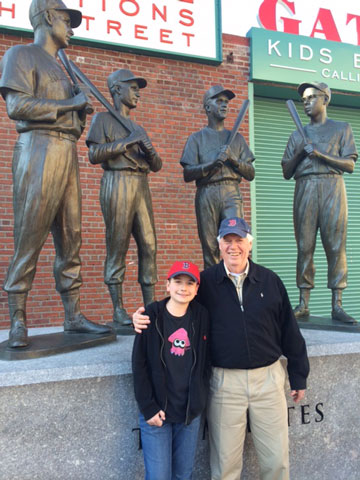
Jimmy Robertston and grandson.
And teaching him that like Joseph Warren and John Quincy Adams, like Robert Gould Shaw and Henry Abbott, not all Boston heroes won all of the battles they fought?
No TRL ballpark report is complete without a culinary report. The days of “buy me some peanuts and Cracker Jack” are long since gone, except as Seventh Inning Stretch lyrics, and mere “Beer, here!” vendors patrolling the grandstands are a fading species.
TRL found the Heineken’s draft at the concession stand behind Section 34 the usual pleasure. Still the IPAs and craft beer were everywhere. At Fenway Budweiser and Millers have definitely taken a market share hit. Thoughts of a variation on the way Boston native Oliver Wendell Holmes, Jr., once put it, “you cannot argue a man into liking a particular glass of beer.”15
A full beverage guide is readily accessible on-line, premium and domestic beers, liquor and cordials, but you would miss several innings of the game to go through the list. A five page concessions guide is equally daunting, from Asian Cuisine to Veggie Burger and Dog, including “Gluten Free/Friendly Franks, Pizza and Snacks/Deserts”.16 Give me a break!
The massive Luxury Suite Menu exists, though it is not clear why. At some of the snooty new “old” ballparks, maybe. But at Fenway Park?!?
Wally’s Clubhouse Amenities and Entertainment is open for the third through seventh innings of each home game, for parents who want to retard their children’s maturity into real members of Red Sox Nation.17
Sunday had been wonderful. The Sox 5–3 loss to the Jays was quickly put aside. September was a long ways away. As the Sun set behind the Charles River all hearts and minds were focused on the day soon to dawn.
Long bus rides out into the New England country side. Interminable waiting, then more waiting. Finally, it happened. The starting gun was fired. The 120th running of the Boston Marathon was under way.
Soon it was 10:30 a.m. The staggered start had been completed. Thousands of heroic runners in Hopkinton had taken their first steps on the grueling gradually downhill grind to Mile 21 and Heartbreak Hill in Newton, again and again, until finally when your quads are burning with pain, more downhill to 665 Boylston Street in Boston.
As the runners began, the Sox and the Jays were set to begin the Patriots’ Day baseball game at Fenway. The first pitch is always at 11:00 a.m. Among the planners’ many hopes are that the fans will disperse before the marathoners start flooding into the finish line area, with but a different sight line from that same CITGO sign.
Jeff Bauman and Jake Gyllenhaal were front and center at the pre-game ceremonies at Fenway. On Marathon day three years ago, Bauman had been standing at the finish line to honor and cheer his finance, Erin Hurley, who was running Boston for the first time. He lost both his legs in the madness of that Monday in 2013. Bauman and Gyllenhaal simultaneously threw out ceremonial first pitches to Red Sox players David Ortiz and Hanley Rameriz.18
An eighth inning two run single off closer Craig Kimbrel hoisted the Jays to a 4 – 3 win over the Sox. Damn!
Most regular 10K runners have at least fantasized about the marathon and being a part of that wave after wave of runners crossing the Boylston Street finish line well over the three hour mark.
The best narrative descriptions of the course/experience are Mile-By-Mile Guide To The Boston Marathon,19 and Boston Marathon Course Tips for Runners.20 Worth a read, if you’ve ever had the fantasy.
Unofficially, the “Scream Tunnel” at Wellesley College21 is the iconic moment in The Marathon. A runner really has to be slow and/or prudish to avoid being kissed by a Wellesley student. The college crowd can be raucous in the Boston College area about Mile 23. Several hours of beer-drinking are still inspiring full throated roars of encouragement as the less-than-elite runners pass, a helpful enhancer for that final resolve to “finish”.
Some of the slower runners are always among the more heroic. Patrick Downes, the lower part of his left leg a prosthesis, finished in 5:56.46. “I ran with the city in my heart — Martin, Sean, Lingzi, Krystie,” Downes told a local television interviewer, naming the four (three spectators and an officer) who died in the bombing and the aftermath, the bombing in which he lost a lower leg. Downes was the first bombing victim to complete the entire marathon on foot.22
Adrienne Haslet had been a ballroom dancer, had competed on Dancing with the Stars. She also lost a lower left leg on April 15, 2013. She struggled in this year’s Marathon, had trouble with her prosthesis, spent more than an hour in a medical tent, then sucked it up, returned to the road and finished.23
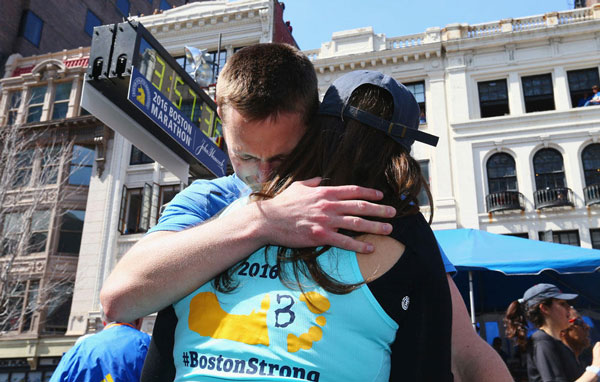
Patrick Downes embracing a friend at the Boston Marathon; from Runner’s World website.
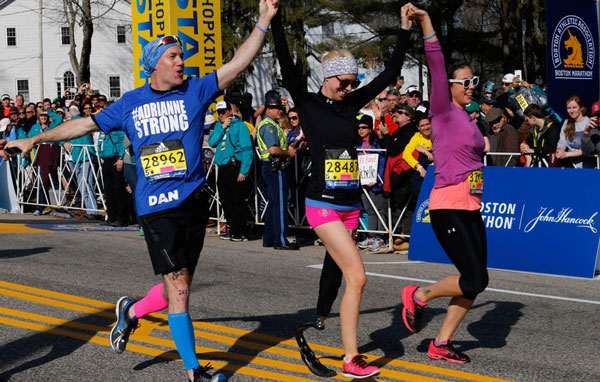
Adrianne Haslet completes the Boston Marathon; from Runner’s World website.
All who finished were heroes. Scott Garrison, 28, of Hattiesburg, finished in 3:07.36. Grace Carroll, 23, of Ocean Springs, finished in 3:28.34. Seventy-four year old Kenneth Williams of Corinth, organizer of the Coca Cola Classic 10K, finished in 4:57.51. Altogether, twenty-one who registered a Mississippi residence, finished.
Lamar Robertson, 45, grew up in Oxford, Mississippi, went to college in the Boston area, and now lives in Silver Spring, MD. He finished in 3:52.50.24
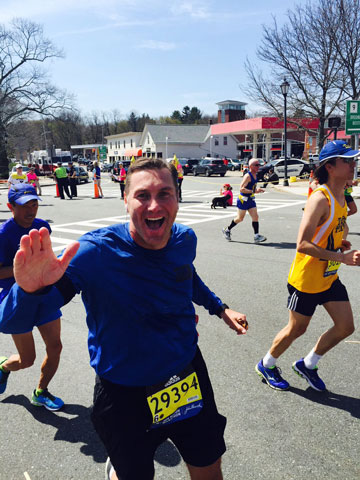
Dan Mullen running the Boston Marathon; from Mullen’s personal twitter.
Mississippi State Bulldog football coach Dan Mullen was a newcomer to distance running. In his 3½ months of focused training, Mullen played by the “golden rule” of marathon training. Do not do a training run longer than 20 miles. That last six will kill you, and you won’t be able to do the marathon.25
What Dan Mullen did is special. His sole resource was his guts and his alone. Few football mad Mississippians have a sense of what it’s like to be out there completely on your own, competing against yourself. No teammate to throw a crucial block, or sacrifice himself, or give an assist in whatever team sport, without which the great athlete would never be seen so great. Only runners know.
Mullen finished in 4 hrs., 28 min., 35 sec.26 A 10:15 per mile pace. Don’t knock it unless you’ve done it.
Mullen learned the meaning of the two parts of a marathon, the first 20 miles and the last six plus. It’s at Mile 21 in Newton that you hit “heartbreak hill”. “Your body is completely exhausted.” “It just becomes a mental challenge to finish.”
The home stretch is a bit past Fenway Park.He could hear the cheers from the finish line. Adrenaline took over. “It was that sense of joy.” “Running that last half-mile was awesome.”
Mullen has raised more than $45,000 for the Mullen 36 Family Foundation that supports children in scholarships, arts, athletics and healthcare.27
There are any number of reasons why The Marathon draws such crowds. It’s a holiday, for one thing. 21st Century Americans love their three day holiday weekends. Yet at once there is more to it than that.
Patriots’ Day is to the Greater Boston Area as the Fourth of July is to Philadelphia. But it is more even than that. It’s a time when we are in awe of those who can summon such courage and strength against great odds. For roughly half a day once each Spring so many locals and people from all over and even from across the seas by common consent come and pause and celebrate our common humanity, and exult in it.
People by the hundreds and then by the thousands bring their folding chairs, their picnic blankets, and line both sides of most of the 26.2 miles from Hopkinton to Ashland to Framingham to Natick to Wellesley to Newton and to glory on Boylston Street near Copley Square.28
So many struggled so hard for the best view of the heroes of the day, a few likely with thoughts of Rev. William Emerson — grandfather of the Transcendentalist — and his family, who from the Old Manse viewed the embattled farmers at the Concord Bridge on the original Patriots’ Day in the Spring of 1775.
Some pick their special spot, set up camp, and admire and celebrate and cheer wave after wave of runners as they pass by. All of this, of course, after they have found a place to park not too far from roadsides in areas where community planners never dreamt of public parking.
Some leap frog to two or more sites. Most of these have a runner they are there to support with a special cheer, at three separate points along the way, if they are lucky, can navigate the narrow two lane back roads from town to town, and find places to park on even narrower back roads.
There are always the handfuls of residential curmudgeons who bring a “Bah! Humbug!” attitude to Marathon Day, and do what they can to shift their self-imposed misery on to those who would park on so much as an inch on their frontage. Fat chance of those types escaping for non-marathon related activities anyway!
Some runners give strict orders to their support group to deliver Gatorade-type concoctions at, again, a maximum of three scientifically selected intervals, oblivious to the logistical difficulties their group will have performing their assigned tasks, evading the curmudgeons, and to the fact that most runners rely on what the BAA provides along the way and otherwise wing it.
At the end of the day, runner after runner credits the cheering crowd for contributing so greatly — and at points (like Wellesley and B.C.) — to the humanity of the Boston experience.
TRL had a taxi pick up at 4:30 a.m. the next morning and began the winding ride through Boston, beneath Boston through the great tunnel. An hour later Logan International Airport was packed. International is the operative word. So many in every line — getting boarding passes, checking baggage, going through security — were showing passports.
Still more bore indicia of the day before. Or at least, like TRL, had been hangers on. There was time. Seems that all knew to get to Logan early that Tuesday morning.
To be sure, there were a handful of regular business travelers, headed some whither to close a big deal. You know the look. The first class seat types. That Tuesday morning was for those with the calm and contented look of heroes and admirers of deeds done and experiences shared that were beyond the understanding of ordinary big shots.